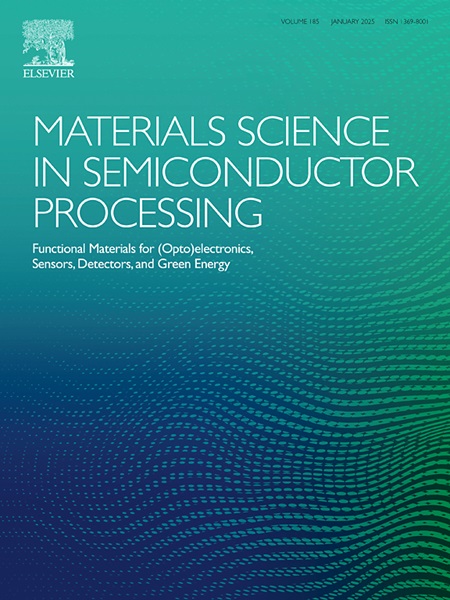Transition metal substitutional doping of graphene nanomeshes: Structural, electronic, and magnetic properties
IF 4.6
3区 工程技术
Q2 ENGINEERING, ELECTRICAL & ELECTRONIC
引用次数: 0
Abstract
Graphene nanomeshes (GNMs) are porous structures that have attracted theoretical and experimental interest over the past decade. Pores of pristine graphene nanomeshes must be passivated by some species (X) to give chemically stable structures (X-GNM). Here, we consider semiconducting GNMs passivated with H, N, and O. We study substitutional implantation of X-GNM with transition metal elements M (M=Sc, Ti, V, Mn, Co, Ni, Cu, Zn), taking into account various doping locations from the center of the pore (P1, P2, P3, P4 and P5 located at 11.47 Å, 10.03 Å, 7.34 Å, 5.57 Å, and 5.98 Å, respectively). We seek to understand how altering the position of the dopant can influence the electronic and magnetic properties of GNM using density functional theory. The pore induces new symmetries compared to the parent graphene structure, requiring the consideration of various doping positions in the X-GNM unit cell. The doped H-GNM structures remain planar, whereas the M atoms in the (N, O)-GNM structures protrude from the plane. The M-(N, O)-GNM systems generally demonstrated stability greater than that of the M-H-GNM, with Co-H-, Ti-(N, O)-GNMs being the most stable structures. We find that the electronic properties and magnetization of the M-X-GNM are M- and X-dependent. Structures can be semiconductors, diluted magnetic semiconductors (DMSC), and metals. Notably, we find that the Ti-X-, the Ni-(N, O)-, and the Zn-N-GNMs are semiconductors, irrespective of the doping location. The (Mn, Co)-(N, O)-, V-(H, O)-, and Cu-N-GNMs are DMSCs, while the (Sc, Co, Cu)-H- and Cu-O-GNMs are metals. The V-N-GNM at position P2 and Co-O-GNM at position P4 are half-metallic systems, and can thus be used in spintronic applications. Our results can be valuable for designing graphene-based semiconductor and spintronic devices.
石墨烯纳米片的过渡金属置换掺杂:结构、电子和磁性能
石墨烯纳米网(gnm)是一种多孔结构,在过去的十年中引起了理论和实验的兴趣。原始石墨烯纳米网的孔隙必须经过某种物质(X)钝化才能得到化学稳定的结构(X- gnm)。我们研究了X-GNM与过渡金属元素M (M=Sc, Ti, V, Mn, Co, Ni, Cu, Zn)的替代植入,考虑了从孔中心开始的不同掺杂位置(P1, P2, P3, P4和P5分别位于11.47 Å, 10.03 Å, 7.34 Å, 5.57 Å和5.98 Å)。我们试图利用密度泛函理论来理解改变掺杂剂的位置如何影响GNM的电子和磁性能。与母体石墨烯结构相比,孔诱导了新的对称性,需要考虑X-GNM单元电池中不同的掺杂位置。掺杂的H-GNM结构保持平面,而(N, O)-GNM结构中的M原子从平面突出。M-(N, O)- gnm体系的稳定性一般高于M- h - gnm,其中Co-H-, Ti-(N, O)- gnm是最稳定的结构。我们发现M- x - gnm的电子性质和磁化强度与M和x有关。结构可以是半导体、稀释磁性半导体(DMSC)和金属。值得注意的是,我们发现无论掺杂位置如何,Ti-X-、Ni-(N, O)-和zn -N- gnm都是半导体。(Mn, Co)-(N, O)-、V-(H, O)-和Cu-N- gnms为DMSCs, (Sc, Co, Cu)-H-和Cu-O- gnms为金属。P2位置的V-N-GNM和P4位置的Co-O-GNM是半金属体系,因此可以用于自旋电子应用。我们的研究结果对石墨烯基半导体和自旋电子器件的设计具有重要价值。
本文章由计算机程序翻译,如有差异,请以英文原文为准。
求助全文
约1分钟内获得全文
求助全文
来源期刊

Materials Science in Semiconductor Processing
工程技术-材料科学:综合
CiteScore
8.00
自引率
4.90%
发文量
780
审稿时长
42 days
期刊介绍:
Materials Science in Semiconductor Processing provides a unique forum for the discussion of novel processing, applications and theoretical studies of functional materials and devices for (opto)electronics, sensors, detectors, biotechnology and green energy.
Each issue will aim to provide a snapshot of current insights, new achievements, breakthroughs and future trends in such diverse fields as microelectronics, energy conversion and storage, communications, biotechnology, (photo)catalysis, nano- and thin-film technology, hybrid and composite materials, chemical processing, vapor-phase deposition, device fabrication, and modelling, which are the backbone of advanced semiconductor processing and applications.
Coverage will include: advanced lithography for submicron devices; etching and related topics; ion implantation; damage evolution and related issues; plasma and thermal CVD; rapid thermal processing; advanced metallization and interconnect schemes; thin dielectric layers, oxidation; sol-gel processing; chemical bath and (electro)chemical deposition; compound semiconductor processing; new non-oxide materials and their applications; (macro)molecular and hybrid materials; molecular dynamics, ab-initio methods, Monte Carlo, etc.; new materials and processes for discrete and integrated circuits; magnetic materials and spintronics; heterostructures and quantum devices; engineering of the electrical and optical properties of semiconductors; crystal growth mechanisms; reliability, defect density, intrinsic impurities and defects.
 求助内容:
求助内容: 应助结果提醒方式:
应助结果提醒方式:


